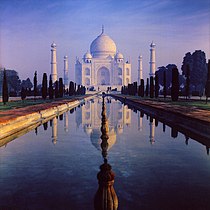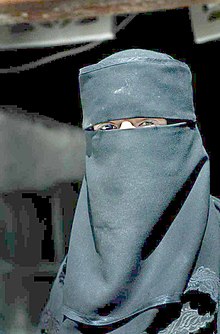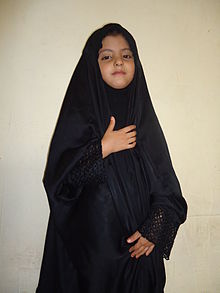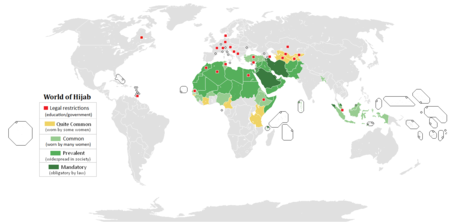Hijab
From Wikipedia, the free encyclopedia
For the municipal company of Gothenburg, Sweden, see
Higab.
A
hijab or
ḥijāb (
,
,
or
;
[1][2][3][4] Arabic:
حجاب,
pronounced [ħiˈdʒæːb] or
[ħiˈɡæːb]) is a
veil that covers the head and chest, which is particularly worn by some
Muslim women beyond the age of
puberty
in the presence of adult males outside of their immediate family. It
can further refer to any head, face, or body covering worn by Muslim
women that conforms to a certain standard of
modesty. Hijab can also be used to refer to the
seclusion of women from men in the
public sphere, or it may embody a metaphysical dimension –
Al-hijab refers to "the veil which separates man or the world from God".
[5]
Most often, it is worn by Muslim women as a symbol of modesty,
privacy and
morality. According to the
Encyclopedia of Islam and Muslim World, modesty in the
Quran concerns both men's and women's "gaze, gait, garments, and genitalia."
[6]
The Qur'an admonishes Muslim women to dress modestly and cover their
breasts and genitals, but it doesn't require covering the head.
[7] Most
Islamic legal systems define this type of modest dressing as covering everything except the face and hands in public.
[5][8] These guidelines (for covering of the entire body except for the hands, the feet and the face) are found in texts of
fiqh and
hadith developed after the revelation of the Qur'an but, according to some, are derived from the verses (
ayahs) referencing hijab in the Qur'an.
[6] Many believe that the Qur'an itself does not mandate that women wear hijab.
[9][10]
The term
hijab in Arabic literally means “a
screen or
curtain” and is used in the Qur'an to refer to a partition. The Qur'an tells the male believers (Muslims) to talk to the wives of
Muhammad
behind a curtain. This curtain was the responsibility of the men and
not the wives of Muhammad. This leads some to claim that the mandate of
the Qur'an to wear hijab applies to the wives of Muhammad, not women
generally.
[11][12]
Αlthough hijab is often seen by critics as a tool utilized by men to
control and silence women, the practice is understood differently in
different contexts.
[13]
In Islamic texts
Quran
The Quran instructs both Muslim men and women to dress in a modest way, but it doesn't insist on covering the head:
"Tell the believing men to lower their gaze and be modest" (
surah 24:30)
The clearest verse on the requirement of the hijab is
surah 24:30–31, asking women to draw their
khimār over their bosoms.
[14][15]
And say to the believing women that they should lower their gaze and
guard their modesty; that they should not display their beauty and
ornaments except what (must ordinarily) appear thereof; that they should
draw their khimār over their breasts and not display their
beauty except to their husband, their fathers, their husband's fathers,
their sons, their husbands' sons, their brothers or their brothers'
sons, or their sisters' sons, or their (Muslim) women, or the slaves
whom their right hands possess, or male servants free of physical needs,
or small children who have no sense of the shame of sex; and that they
should not strike their feet in order to draw attention to their hidden
ornaments. (Quran 24:31)
In the following verse, the wives of Muhammad are asked to wear
clothes (when they go out), as a measure to distinguish themselves from
others, so that they are not harassed. Surah 33:59 reads:
[15]
Those who harass believing men and believing women undeservedly, bear
(on themselves) a calumny and a grievous sin. O Prophet! Enjoin your
wives, your daughters, and the wives of true believers that they should
cast their outer garments over their persons (when abroad): That is most
convenient, that they may be distinguished and not be harassed. [...] (Quran 33:58–59)
Alternative views
Some Muslims take a relativist approach to hijab. They believe that the commandment to maintain
modesty
must be interpreted with regard to the surrounding society. What is
considered modest or daring in one society might not be considered so in
another. It is important, they say, for believers to wear clothing that
communicates modesty and reserve.
[16]
Along with scriptural arguments,
Leila Ahmed
argues that head covering should not be compulsory in Islam because the
veil predates the revelation of the Qur'an. Head-covering was
introduced into Arabia long before Muhammad, primarily through Arab
contacts with Syria and Iran, where the hijab was a sign of social
status. After all, only a woman who need not work in the fields could
afford to remain secluded and veiled.
[11][17]
Ahmed argues for a more liberal approach to hijab. Among her
arguments is that while some Qur'anic verses enjoin women in general to
"draw their
Jilbabs (overgarment or cloak) around them to be recognized as believers and so that no harm will come to them"
[Quran 33:58–59] and "guard their private parts... and drape down
khimar over their breasts [when in the presence of unrelated men]",
[Quran 24:31] they urge modesty. The word "khimar" refers to a piece of cloth that covers the head, or headscarf.
[18] While the term "hijab" was originally anything that was used to conceal,
[19] it became used to refer to concealing garments worn by women outside the house, specifically the headscarf or khimar.
[20]
Other verses do mention separation of men and women.
Abide still in your homes and make not a dazzling display like that of the former times of ignorance[Quran 33:32–33]
And when ye ask of them [the wives of the Prophet] anything, ask it of them from behind a curtain.[Quran 33:53]
According to at least three authors (
Karen Armstrong,
Reza Aslan
and Leila Ahmed), the stipulations of the hijab were originally meant
only for Muhammad's wives, and were intended to maintain their
inviolability. This was because Muhammad conducted all religious and
civic affairs in the mosque adjacent to his home:
People were constantly coming in and out of this compound at all
hours of the day. When delegations from other tribes came to speak with
Prophet Muhammad, they would set up their tents for days at a time
inside the open courtyard, just a few feet away from the apartments in
which Prophet Muhammad's wives slept. And new emigrants who arrived in Yatrib would often stay within the mosque's walls until they could find suitable homes.[11]
According to Ahmed:
By instituting seclusion Prophet Muhammad was creating a distance
between his wives and this thronging community on their doorstep.[12]
They argue that the term
darabat al-hijab ("taking the veil"),
was used synonymously and interchangeably with "becoming Prophet
Muhammad's wife", and that during Muhammad's life, no other Muslim woman
wore the hijab. Aslan suggests that Muslim women started to wear the
hijab to emulate Muhammad's wives, who are revered as "Mothers of the
Believers" in Islam,
[11] and states "there was no tradition of veiling until around 627 C.E." in the Muslim community.
[11][12]
Another interpretation differing from the traditional states that a
veil is not compulsory in front of blind men and men lacking physical
desire.
[21][22][23]
Hadith
The Arabic word
jilbab is translated as "cloak" in the following passage. Contemporary
Salafis insist that the
jilbab
(which is worn over the Kimaar and covers from the head to the toe)
worn today is the same garment mentioned in the Qur'an and the
hadith; other translators have chosen to use less specific terms:
- Narrated Anas ibn Malik: "I know (about) the Hijab (the order of veiling of women) more than anybody else. Ubay ibn Ka'b used to ask me about it. Allah's Apostle became the bridegroom of Zaynab bint Jahsh
whom he married at Medina. After the sun had risen high in the sky, the
Prophet invited the people to a meal. Allah's Apostle remained sitting
and some people remained sitting with him after the other guests had
left. Then Allah's Apostle got up and went away, and I too, followed him
till he reached the door of 'Aisha's room. Then he thought that the
people must have left the place by then, so he returned and I also
returned with him. Behold, the people were still sitting at their
places. So he went back again for the second time, and I went along with
him too. When we reached the door of 'Aisha's room, he returned and I
also returned with him to see that the people had left. Thereupon the
Prophet hung a curtain between me and him and the Verse regarding the
order for (veiling of women) Hijab was revealed." Sahih al-Bukhari, 7:65:375, Sahih Muslim, 8:3334
- Narrated Umm Salama Hind bint Abi Umayya,
Ummul Mu'minin: "When the verse 'That they should cast their outer
garments over their persons' was revealed, the women of Ansar came out
as if they had crows hanging down over their heads by wearing outer
garments." 32:4090. Abū Dawud classed this hadith as authentic.
- Narrated Safiya bint Shaiba: "Aisha used to say: 'When (the Verse): "They should draw their veils (Khumur) over their necks and bosoms (juyyub)," was revealed, (the ladies) cut their waist sheets at the edges and covered their faces with the cut pieces.'" Sahih al-Bukhari, 6:60:282, 32:4091.
Dress code required by hijab
Traditionally, Muslims have recognized many different forms of clothing as satisfying the demands of
hijab.
[24]
Debate focused on how much of the male or female body should be
covered. Different scholars adopted different interpretations of the
original texts.
Women
Detailed scholarly attention has focused on prescribing female dress in conformity with hijab. The four major
Sunni schools of thought (
Hanafi,
Shafi'i,
Maliki and
Hanbali) hold that the entire body of the woman, except her face and hands – though a few clerics
[who?] say face, hands – must be covered during prayer and in public settings (see
Awrah). There are those who allow the feet to be uncovered as well as the hands and face.
[25][26]
It is recommended that women wear clothing that is not form fitting
to the body: either modest forms of western clothing (long shirts and
skirts), or the more traditional
jilbāb, a high-necked, loose robe that covers the arms and legs. A
khimār or
shaylah,
a scarf or cowl that covers all but the face, is also worn in many
different styles. Some scholars encourage covering the face, while some
follow the opinion that it is only not obligatory to cover the face and
the hands but mustahab (Highly recommended). Other scholars oppose face
covering, particularly in the West, where the woman may draw more
attention as a result. These garments are very different in cut from
most of the traditional forms of
ħijāb, and they are worn worldwide by Muslims.
Many Muslim scholars believe that it is a basic requirement of
Islamic law that women keep their hair and bodies covered in the
presence of people of the opposite sex other than close family members
(those close enough to be forbidden to marry—see
mahram). These include the Iraqi Shia
Marja' (Grand
Ayatollah)
Ali al-Sistani;
[27] the Sunni
Permanent Committee for Islamic Research and Issuing Fatwas in Saudi Arabia;
[28] and others.
[29]
According to some interpretations, these requirements extend to
non-Muslim women as well. Some believers go so far as to specify exactly
which areas of the body must be covered. In some cases, this is
everything but the eyes, but most require that women cover everything
but the face and hands. In nearly all Muslim cultures, young girls are
not required to wear a ħijāb. There is not a single agreed age when a
woman should begin wearing a ħijāb—but in many Muslim cultures, puberty
is the dividing line.
In private, and in the presence of close relatives (
mahrams),
rules on dress relax. However, in the presence of the husband, most
scholars stress the importance of mutual freedom and pleasure of the
husband and wife.
[30]
Garments
The
burqa
(also spelled burka) is the garment that covers women most completely:
either only the eyes are visible, or nothing at all. Originating in what
is now Pakistan, it is more commonly associated with the
Afghan chadri. Typically, a
burqa
is composed of many yards of light material pleated around a cap that
fits over the top of the head, or a scarf over the face (save the eyes).
This type of veil is cultural as limited to the people of that part of
the world.
It has become tradition that Muslims in general, and
Salafis in particular, believe the Qur'an demands women wear the garments known today as
jilbāb and
khumūr (the
khumūr must be worn underneath the
jilbāb). However, Qur'an
translators and commentators translate the Arabic into English words with a general meaning, such as veils, head-coverings and shawls.
[31] Ghamidi argues that verses
[Quran 24:30] teach etiquette for male and female interactions, where
khumūr
is mentioned in reference to the clothing of Arab women in the 7th
century, but there is no command to actually wear them in any specific
way. Hence he considers head-covering a preferable practice but not a
directive of the
sharia (law).
[32]
Men
Although certain general standards are widely accepted, there has
been little interest in narrowly prescribing what constitutes modest
dress for Muslim men. Many scholars recommend that men should cover
themselves from the
navel to the
knees.
[33] It is also widely accepted that male clothes should not be tight-fitting or "glamorous".
[33]
According to some sources, Muslim men should not wear gold jewelry, silk clothing, or adornments that are considered feminine.
[34][35]
Fadwa El Guindi, a prominent Islamic scholar, writes, “Confining the
study of the veil, just like the study of women, to the domain of gender
in lieu of society and culture narrows the scope in a way that limits
cultural understanding and theoretical conceptualization”
[citation needed]
Sartorial hijab as practiced
A young girl from the city of
Ahwaz in Iran wearing a
chador
In Iran, where wearing the hijab is legally required, women,
especially younger ones, have taken to wearing transparent and very
loosely worn hijabs.
In Turkey, where the hijab was formerly banned in private and state
universities and schools, 11% of women once wore it, though 60% wore
traditional non-Islamic headscarves, figures of which are often confused
with hijab.
[36][37][38] However, the ban was lifted from universities in 2011, from government buildings in 2013,
[39] and from schools in 2014.
[40]
Historical and cultural explanations
History
The term
hijab is never used in the Qur'an to describe an article of clothing.
[41]
The only verses in the Qur'an that specifically reference women’s
clothing, are those promoting modesty, instructing women to guard their
private parts and throw a scarf over their bosoms in the presence of
men.
[41]
The contemporary understanding of the hijab dates back to Hadith when
the “verse of the hijab” descended upon the community in 627 CE.
[42]
Now documented in Sura 33: 53 the verse states, “And when you ask [his
wives] for something, ask them from behind a partition. That is purer
for your hearts and their hearts”.
[43]
This verse, however, was not addressed to women in general, but
exclusively to Muhammad’s wives. As Muhammad’s influence increased, he
entertained more and more visitors in the mosque, which was then his
home. Often, these visitors stayed the night only feet away from his
wives’ apartments. It is commonly understood that this verse was
intended to protect his wives from these strangers.
[44]
During Muhammad’s lifetime no other women in the Ummah (Muslim
community) observed the hijab. Instead, the term for donning the veil,
darabat al-hijab, was used interchangeably with “becoming Muhammad’s wife”.
[45]
As stated by Reza Aslan, “The veil was neither compulsory nor widely
adopted until generations after Muhammad’s death, when a large body of
male scriptural and legal scholars began using their religious and
political authority to regain the dominance they had lost in society as a
result of the Prophet’s egalitarian reforms”.
[44]
Other scholars point out that the Qur'an does not require women to wear
veils; rather, it was a social habit picked up with the expansion of
Islam. In fact, since it was impractical for working women to wear
veils, "A veiled woman silently announced that her husband was rich
enough to keep her idle."
[46]
Young woman from
Nablus in a hijab (ca. 1867-1885)
Pre-Islamic Veiling Practices
Veiling did not originate with the advent of Islam. Statuettes
depicting veiled priestesses precede all three Abrahamic religions
(Christianity, Judaism, and Islam), dating back as far as 2500 BCE.
[47]
Elite women in ancient Mesopotamia and in the Byzantine, Greek, and
Persian empires wore the veil as a sign of respectability and high
status.
[48] In ancient Mesopotamia, Assyria had explicit
sumptuary laws
detailing which women must veil and which women must not, depending
upon the woman’s class, rank, and occupation in society. Veiling was
meant to “differentiate between ‘respectable’ women and those who were
publicly available”.
[48]
Female slaves and unchaste women were explicitly forbidden to veil and
suffered harsh penalties if they did so. Veiling was thus a marker of
rank and exclusive lifestyle, subtly illustrating upper-class women’s
privilege over women in lower classes in the Assyrian community.
Strict seclusion and the veiling of matrons were in place in Roman
and Byzantine society as well. Between 550 and 323 B.C.E, prior to
Christianity, respectable women in classical Greek society were expected
to seclude themselves and wear clothing that concealed them from the
eyes of strange men.
[49]
These customs influenced the later Byzantine empire where proper
conduct for girls entailed that they be neither seen nor heard outside
their home. Like in Assyrian law, respectable women were expected to
veil and low-class women were forbidden from partaking in the practice.
In Classical Rome, the Emperor Augustus encouraged his citizens all
around the Mediterranean to enter temples "capo velato" literally "with
their heads veiled", by which he intended clothing that did not differ
much from traditional Saudi clothing for men and women today. Augustus
himself appeared like this in propaganda pictures and temple portraits
(see the
Ara Pacis
temple in Rome). The Romans were embedded in a larger
Mediterranean/Middle Eastern milieu with roots in Mesopotamia (Iraq) and
Egypt, and they transmitted this legacy to both the eastern and western
parts of the Roman Empire, which today constitute approximately the
Muslim Mediterranean (and parts of the Middle East) and Europe.
By the 5th and 6th centuries, societies of the Mediterranean Middle
East were dominated by Christian and some Jewish populations. At the
inception of Christianity, Jewish women were veiling the head and face.
In Judaic scripture,
Genesis 24:65,
Numbers 5:18 and
Isaiah 47:2 are references in the
Old Testament
refer to a headcovering for women. Although there is no positive
command for women to cover their heads in the Old Testament, there are
non-canonical rabbinical writings on
tzniut, meaning "modesty".
[50]
There is also a tradition of
Christian headcovering for women, rooted in
1 Corinthians 11:2–16 and supported by various early
Church Fathers[51][52][53][54][55] Early Christian art shows women wearing headcoverings.
[56] During the ensuing centuries, women wore headcoverings during the meetings of the church, but the style of the covering varied.
[57]
The practice of head-covering gradually disappeared from most churches
over the course of the twentieth century, but still persists in the form
of
nuns "taking the veil," and many orders of nuns'
religious habits resemble the
chador,
the full-body cloak that leaves only the face exposed, which is worn as
a form of hijab by some women, particularly in Iran. Some think that
the word
habarah (a complex cloak and veil traditional in Egypt) itself derives from early Christian and Judaic religious vocabulary.”
[58]
Scholar Leila Ahmed argues that “Whatever the cultural source or
sources, a fierce misogyny was a distinct ingredient of Mediterranean
and eventually Christian thought in the centuries immediately preceding
the rise of Islam.”
[59]
During the period directly preceding the Muslim conquest in 640 CE, the
Sassanids
ruled in Mesopotamia. Customs of Persian royalty at the time of the
first Persian conquest of Mesopotamia continued to be practiced and
became even more elaborate under the Sassanids. In addition to
acknowledging the monotheistic religion of
Zoroastrianism
among the upper classes, such customs included large harems of women
and, of most note for this article, veiling. Some scholars postulate
that the customs of veiling and seclusion of women in early Islam were
assimilated from the conquered
Persian and
Byzantine societies and then later on they were viewed as appropriate expressions of Quranic norms and values.
Thus, successive invasions during the Muslim conquest led to some
synthesis in the cultural practices of Greek, Persian, and Mesopotamian
empires and the Semitic peoples of the regions.
[58]
Because Islam identified with the monotheistic religions of the
conquered empires, the practice was adopted as an appropriate expression
of Qur'anic ideals regarding modesty and piety.
[60]
Veiling gradually spread to upper-class Arab women, and eventually it
became widespread among Muslim women in cities throughout the Middle
East. It gradually spread among urban populations, becoming more
pervasive under Ottoman rule as a mark of rank and exclusive lifestyle.
[58] Women in rural areas were much slower to adopt veiling because the garments interfered with their work in the fields.
[61]
The mid-twentieth century saw a resurgence of the hijab in
Egypt after a long period of decline as a result of the westernization of Egypt under the rule of
Gamal Abdel Nasser.
The hijab, veil, often taken to mean suppression of the Islamic woman,
began to symbolize a commitment to "the service of the Islamic call [to
help] devastated families."
[62] The veil became a liberating symbol of being an Islamic woman with a cause for social justice.
Overall, the hijab is meant to highlight the individual’s relationship with Allah. Many scholars
[who?] believe that the hijab was a source of separation, in which to allow Muhammad’s wives to find oneness with Allah.
Contemporary context
A model displaying a fashionable hijab at "Moslema In Style Fashion Show" (show for Muslim women apparels)
The mid-1970s marked a period in which college aged Muslim men and
women began a movement meant to reunite and rededicate themselves to the
Islamic faith.
[63][64] This movement was named the Sahwah,
[65]
or awakening, and was and sparked a period of heightened religiosity
that spread across the east that was evident in every aspect of the
believers life through the ways in which they chose to dress themselves.
[63]
The uniform adopted by the young female pioneers of this movement was
named al-Islāmī (Islamic dress) and was made up of an “al-
jilbāb—an
unfitted, long-sleeved, ankle-length gown in austere solid colors and
thick opaque fabric—and al-khimār, a head cover resembling a nun's
wimple that covers the hair low to the forehead, comes under the chin to conceal the neck, and falls down over the chest and back”.
[63]
In addition to the basic garments that were mostly universal within the
movement, additional measures of modesty could be taken depending on
how conservative the followers wished to be. Some women choose to also
utilize a face covering (al-
niqāb) that leaves only eye slits for sight, as well as both gloves and socks in order to reveal no visible skin.
Soon this movement expanded outside of the youth realm and became a
more widespread Muslim practice. Women viewed this way of dress as a way
to both publicly announce their religious beliefs as well as a way to
simultaneously reject western influences of dress and culture that were
prevalent at the time. Despite many criticisms of the practice of hijab
being oppressive and detrimental to women’s equality,
[64]
many Muslim women view the way of dress to be a positive thing. It is
seen as a way to avoid harassment and unwanted sexual advances in public
and works to desexualize women in the public sphere in order to instead
allow them to enjoy equal rights of complete legal, economic, and
political status. This modesty was not only demonstrated by their chosen
way of dress but also by their serious demeanor which worked to show
their dedication to modesty and Islamic beliefs.
[63]
Controversy erupted over the practice. Many people, both men and
women from backgrounds of both Islamic and non-Islamic faith questioned
the hijab and what it stood for in terms of women and their rights.
There was questioning of whether in practice the hijab was truly a
female choice or if women were being coerced or pressured into wearing
it.
[63]
Many instances, such as a period of forced veiling for women in Iran,
brought these issues to the forefront and generated great debate from
both scholars and everyday people.
As the awakening movement gained momentum, its goals matured and
shifted from promoting modesty and Islamic identity towards more of a
political stance in terms of retaining support for Islamic nationalism
and to resist western influences. Today the hijab means many different
things for different people. For Islamic women who choose to wear the
hijab it allows them to retain their modesty, morals and freedom of
choice.
[64]
They choose to cover because they believe it is liberating and allows
them to avoid harassment. Many people (both Muslim and non-Muslim) are
against the wearing of the hijab and argue that the hijab causes issues
with gender relations, works to silence and repress women both
physically and metaphorically, and have many other problems with the
practice. This difference in opinions has generated a plethora of
discussion on the subject, both emotional and academic, which continues
today.
Ever since September 11, 2001, the discussion and discourse on the
hijab has intensified. Many nations have attempted to put restrictions
on the hijab, which has led to a new wave of rebellion by women who
instead turn to covering and wearing the hijab in even greater numbers.
[64][66] Some of the more notable events that have occurred in the recent past can be read about in the further reading section.
Modern practice
Wearing the hijab in
Kazakhstan
is not prohibited, but is widely criticized as a foreign custom (the
traditional scarf worn by Central Asian married women resemble the
bandana, not the hijab), because it was not practiced until the fall of
the USSR and the arrival of foreign Islamic missionaries.
Governmental enforcement and bans
A map showing the prevalence of the Hijab
Some governments encourage and even oblige women to wear the hijab,
while others have banned it in at least some public settings.
Some Muslims believe hijab covering for women should be compulsory as part of
sharia, i.e. Muslim law. Wearing of the hijab was enforced by the
Taliban regime in
Afghanistan. The Taliban's
Islamic Emirate of Afghanistan
required women to cover not only their head but their face as well,
because "the face of a woman is a source of corruption" for men not
related to them.
[67] Today, covering face by
niqab is compulsory in many sacred places in the
Kingdom of Saudi Arabia.
Turkey, Tunisia, and Tajikistan are Muslim-majority countries where
the law prohibits the wearing of hijab in government buildings, schools,
and universities. In Tunisia, women were banned from wearing hijab in
state offices in 1981 and in the 1980s and 1990s more restrictions were
put in place.
[68]
In 2008 the Turkish government attempted to lift a ban on Muslim
headscarves at universities, but were overturned by the country's
Constitutional Court.
[69] Though in December 2010, the Turkish government ended the headscarf ban in universities.
[70]
Iran
went from banning hijab in 1936 to making it compulsory in 1979. The
tradition of veiling hair in Iranian culture has ancient pre-Islamic
origins,
[71] but the widespread custom was forcibly ended by
Reza Shah's
regime in 1936, as it was incompatible with his modernizing ambitions.
The police arrested women who wore the veil and would forcibly remove
it, and these policies outraged the
Shi'a
clerics, and ordinary men and women, to whom appearing in public
without their cover was tantamount to nakedness. Many women refused to
leave the house out of fear of being assaulted by Reza Shah's police.
[72]
Eventually rules of dress code were relaxed, and after Reza Shah's
abdication in 1941 the compulsory element in the policy of unveiling was
abandoned. According to
Mohammad Reza Shah Pahlavi,
between 1941 and 1979, wearing hejab [hijab] was no longer offensive,
but still considered it to be a real hindrance to climbing the social
ladder, a badge of backwardness and a marker of class. A headscarf, let
alone the chador, prejudiced the chances of advancement in work and
society not only of working women but also of men, who were increasingly
expected to appear with their wives at social functions. At the time of
the overthrow of the Shah's regime after
Iranian Revolution of 1979,
Ayatollah Ruhollah Khomeini made a speech on the first International Women's Day declaring that women should wear the veil in state ministries.
[73][74]
This led to widespread demonstrations in March of 1979 by women all
across the country by women opposed to the imposition of the veil.
[73][74]
However, legally-imposed veiling gradually took hold: women not
covering their hair and body in hijab were first denied the right to
enter governmental institutions and facilities, and hijab ultimately
became universally mandatory in 1984.
[74] Under Penal Code provisions, women who refuse to wear the prescribed hijab will be sentenced to 72 lashes.
[74]
Some Iranian women wear their headscarves far back on their heads
revealing most of their hair. More conservative types of hijab like
kimars and
chadors are still widespread in government institutions, mosques, sacred places and conservative areas.
On March 15, 2004, France passed a
law
banning "symbols or clothes through which students conspicuously
display their religious affiliation" in public primary schools, middle
schools, and secondary schools. In the
Belgian city of
Maaseik,
Niqāb has been banned since 2006.
[75]
On July 13, 2010, France's lower house of parliament overwhelmingly
approved a bill that would ban wearing the Islamic full veil in public.
There were 335 votes for the bill and one against in the 557-seat
National Assembly.
In 2014 the
Islamic State of Iraq and the Levant was reported to have executed several women for not wearing niqab with gloves.
[76]
In 2014 the
Aceh
Legislative Council passed Qanun Acara Jinayat (a sharia-based criminal
procedures code) applying Islamic law to everyone in the province,
including non-Muslims. This would compel non-Muslims to wear hijab. The
bill is under national government review.
[77]
Non-governmental enforcement
Non-governmental enforcement of hijab is found in many parts of the Muslim world.
Successful informal coercion of women by sectors of society to wear hijab has been reported in
Gaza where Mujama' al-Islami, the predecessor of
Hamas,
reportedly used "a mixture of consent and coercion" to "'restore'
hijab" on urban educated women in Gaza in the late 1970s and 1980s.
[78]
Similar behaviour was displayed by Hamas itself during the
First Intifada
in Palestine. Though a relatively small movement at this time, Hamas
exploited the political vacuum left by perceived failures in strategy by
the Palestinian factions to call for a 'return' to Islam as a path to
success, a campaign that focused on the role of women.
[79]
Hamas campaigned for the wearing of the hijab alongside other measures,
including insisting women stay at home, segregation from men and the
promotion of
polygamy.
In the course of this campaign women who chose not to wear the hijab
were verbally and physically harassed, with the result that the hijab
was being worn 'just to avoid problems on the streets'.
[80]
In
Srinagar, India in 2001 an "
acid attack
on four young Muslim women ... by an unknown militant outfit [was
followed by] swift compliance by women of all ages on the issue of
wearing the
chadar (head-dress) in public."
[81][82][83]
Radicals in Gaza have been accused of attacking or threatening to
attack the faces of women in an effort to intimidate them from wearing
allegedly immodest dress.
[84]
World Hijab Day
World Hijab Day is an annual event that takes place on February 1. The very first World Hijab Day was celebrated in 2013. Founded by
Nazma Khan,
it is a worldwide event that encourages Muslim and non-Muslim women to
wear the hijab, and experience life of a Hijabi woman. This event
showcases freedom and traditional aspect of hijab to the women of the
116 participating countries. In short, World Hijab Day is a way for the
non-Hijabi woman to experience hijab from the other side.
[85]

















